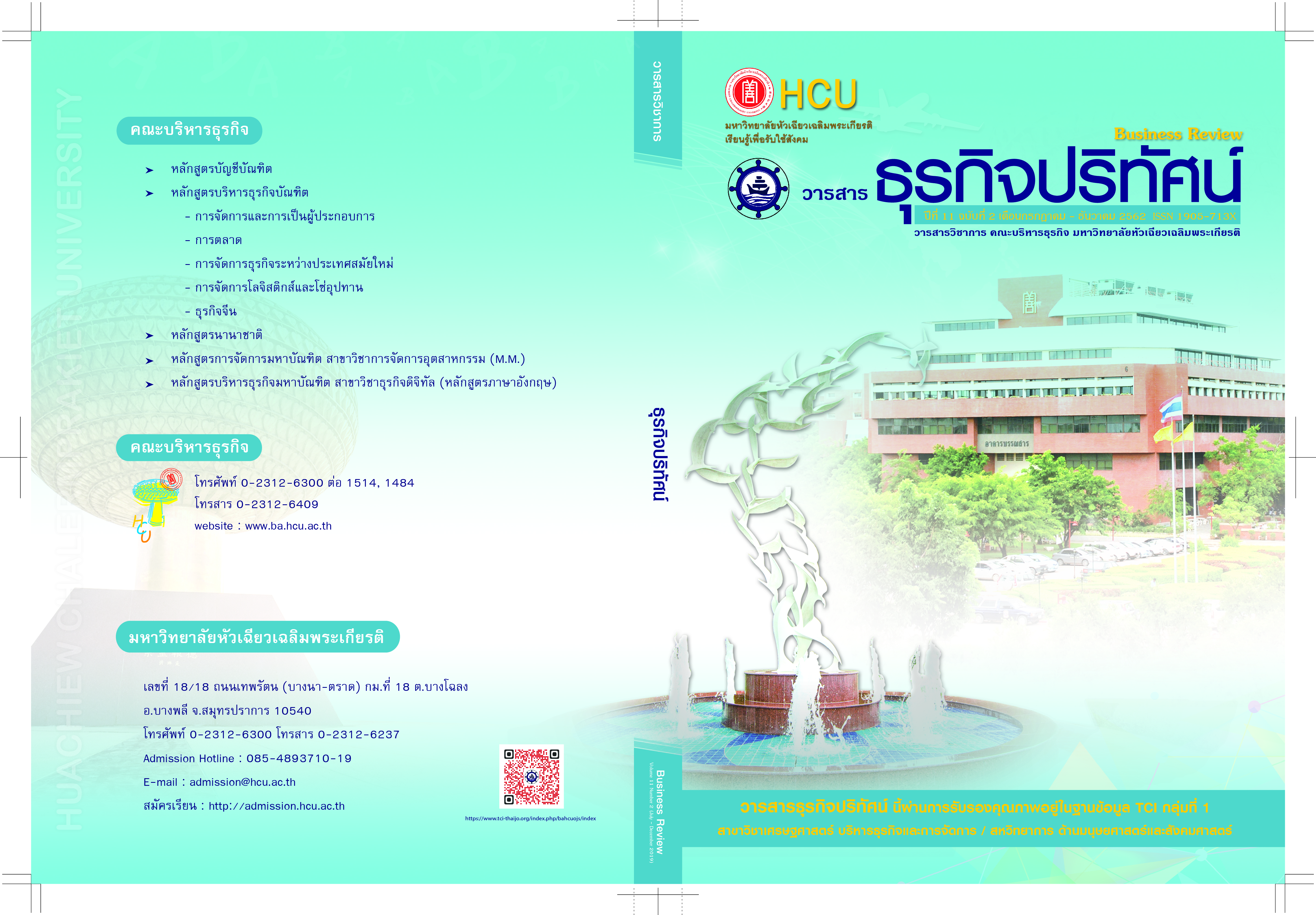Determinants of Relative Risk Aversion: The case of Thai High Net Worth Investor
Keywords:
Relative Risk Aversion, Demographics, High Net Worth Investor, ThailandAbstract
To add the empirical evidence of the relationship between wealth and relative risk aversion, this paper studies the proportion of holding risky assets for a special group of investor who is considered as High Net Worth Investors (HNWs) in Thailand. Also, the demographic characteristics of investors are determined the effects on relative risk aversion. OLS technique is utilized to find significant relationship among variables and mean different test is also used to compared average proportional risky assets holding among sample characteristics. Results pointe to decreasing relative risk aversion and the demographic characteristics as age, sex, income, and occupation related to weight of risky assets in portfolio. When the definition of wealth is defined to either only financial assets or financial assets less value of debt from total aggregated wealth, the finding on relative risk aversion were also presented decreasing relative risk aversion across investors.
References
Jahnssonin Saatio.
Arrow, K. J. (1971). Essays in the theory of risk-bearing, Amsterdam: North-Holland Publishing
Company.
Bajtelsmit, V. L. & Bernasek, A. (1996). Why do woman invest differently than men?. Financial
Counseling and planning, 7(1), 1-10.
Bangkok Post Online Reporters. (2018). Thailand Wealth Report. Retrieved August 14, 2019, from
Bangkok Post Public Company Limited website: https://www.bangkokpost.com/business/
news/1588786/report-thailand-most-unequal-country-in-2018
Bellante, D., & Saba, R. P. (1986). Human capital and life-cycle effects on risk aversion. Journal
of Financial Research, 9(1), 41-51.
Brown, D. P. (1990). Age clienteles induced by liquidity constraints. International Economic
Review, 891-912.
Bucciol, A., & Miniaci, R. (2011). Household portfolios and implicit risk preference. Review of
Economics and Statistics, 93(4), 1235-1250.
Carroll, C. D. (2000). Portfolios of the Rich, Household portfolios. Cambridge, MA: MIT Press.
Cohen, A., & Einav, L. (2007). Estimating risk preferences from deductible choice. American
economic review, 97(3), 745-788.
Cohn, R. A., Lewellen, W. G., Lease, R. C., & Schlarbaum, G. G. (1975). Individual investor risk
aversion and investment portfolio composition. The Journal of Finance, 30(2), 605-620.
Dohmen, T., Falk, A., Huffman, D., Sunde, U., Schupp, J., & Wagner, G. G. (2011). Individual
risk attitudes: Measurement, determinants, and behavioral consequences. Journal of the
European Economic Association, 9(3), 522-550.
Fama, E. F., & Schwert, G. W. (1977). Human capital and capital market equilibrium. Journal of
Financial Economics, 4(1), 95-125.
Friend, I. (1973). Mythodology in finance. The Journal of Finance, 28(2), 257-272.
Friend, I., & Blume, M. (1975). The Demand for Risky Assets. The American Economic Review,
65(5), 900-922
Green, S. B. (1991). How many subjects does it take to do a regression analysis. Multivariate behavioral
research, 26(3), 499-510.
Grossman, S. J., & Shiller, R. J. (1981). The determinants of the variability of stock market prices.
American Economic Review, 71(2), 222-227.
Hardeweg, B., Menkhoff, L., & Waibel, H. (2013). Experimentally validated survey evidence on individual
risk attitudes in rural Thailand. Economic Development and Cultural Change, 61(4), 859-888.
Harrison, G. W., Lau, M. I., & Rutström, E. E. (2007). Estimating risk attitudes in Denmark: A field
experiment. scandinavian Journal of Economics, 109(2), 341-368.
Jianakoplos, N. A., & Bernasek, A. (1998). Are women more risk averse?. Economic inquiry, 36(4),
620-630.
Kydland, F. E., & Prescott, E. C. (1982). Time to build and aggregate fluctuations. Econometrica,
50, 1345-1370.
Landskroner, Y. (1977). Nonmarketable assets and the determinants of the market price of risk.
The Review of Economics and Statistics, 59(4), 482-492.
Lease, R. C., Lewellen, W. G., & Schlarbaum, G. G. (1974). The individual investor: attributes and
attitudes. The Journal of Finance, 29(2), 413-433.
Liberman, J. (1980). Human capital and the financial capital market. Journal of Business, 53, 165-191.
Lin, F. T. (2009). Does the risk aversion vary with different background risk of households?. International
Research Journal of Finance and Economics, 34(34), 69-82.
Liu, X., Yang, F., & Cai, Z. (2016). Does relative risk aversion vary with wealth? Evidence
from households̛ portfolio choice data. Journal of Economic Dynamics and Control,
69, 229-248.
Markowitz, H. (1952). Portfolio selection. The journal of finance, 7(1), 77-91.
Markowitz, H. (1959). Portfolio Selection: Efficient diversification of investment. New York:
John Wiley & Sons Inc.
Mayer, R. H., & Levy, D. R. (2003). Financial Planning for High Net Worth Individuals.
Washington DC: Beard Books.
Mehra, R., & Prescott, E. C. (1985). The equity premium: A puzzle. Journal of monetary
Economics, 15(2), 145-161.
Merton, R. C. (1969). Lifetime portfolio selection under uncertainty: The continuous-time case.
Review of Economics and Statistics, 50, 247-257.
Morin, R. A., & Suarez, A. F. (1983). Risk aversion revisited. The Journal of Finance, 38(4), 1201-1216.
Neumann, J. Von., & Morgenstern, O. (1947). Theory of games and economic behavior (2nd ed.).
Princeton: Princeton University Press.
Pratt, J. W. (1964). Risk aversion in the small and in the large. Econometrica, 32 (1). 122-136.
Riley Jr, W. B., & Chow, K. V. (1992). Asset allocation and individual risk aversion. Financial
Analysts Journal, 48(6), 32-37.
Samuelson, P. A. (1967). General proof that diversification pays. Journal of Financial and
Quantitative Analysis, 2(1), 1-13.
Samuelson, P. A. (1969). Lifetime portfolio selection by dynamic stochastic programming.
The Review of Economics and Statistics, 51(3), 239-246.
Schieber, S. J., & Shoven, J. B. (1996). The consequences of population aging for private pension
fund saving and asset markets. Cambridge: MIT Press.
Schooley, D. K., & Worden, D. D. (1996). Risk aversion measures: comparing attitudes and asset
allocation. Financial Services Review, 5(2), 87–99
Securities and Exchange Commission. (2017). Qualification of High Net Worth Investor. Retrieved
August 14, 2019, from The Securities and Exchange Commission, Thailand website: https://
capital.sec.or.th/webapp/nrs/data/7186s.pdf
Siegel, F. W., & Hoban, J. P. (1982). Relative risk aversion revisited. The Review of Economics
and Statistics, 64(3), 481-487.
Tobin, J. (1958). Liquidity preference as behavior towards risk. The review of economic studies,
25(2), 65-86.
Wei, S. J., Wu, W., & Zhang, L. (2018). Portfolio choices, Asset returns and wealth inequality:
evidence from China. Emerging Markets Review, 38, 423-437.
Downloads
Published
How to Cite
Issue
Section
License
บทความที่ได้รับการตีพิมพ์เป็นลิขสิทธิ์ของวารสารธุรกิจปริทัศน์
ข้อความที่ปรากฏในบทความแต่ละเรื่องในวารสารวิชาการเล่มนี้เป็นความคิดเห็นส่วนตัวของผู้เขียนแต่ละท่านไม่เกี่ยวข้องกับมหาวิทยาลัยหัวเฉียวเฉลิมพระเกียรติ และคณาจารย์ท่านอื่น ๆ ในมหาวิทยาลัยฯ แต่อย่างใด ความรับผิดชอบองค์ประกอบทั้งหมดของบทความแต่ละเรื่องเป็นของผู้เขียนแต่ละท่าน หากมีความผิดพลาดใดๆ ผู้เขียนแต่ละท่านจะรับผิดชอบบทความของตนเองแต่ผู้เดียว





